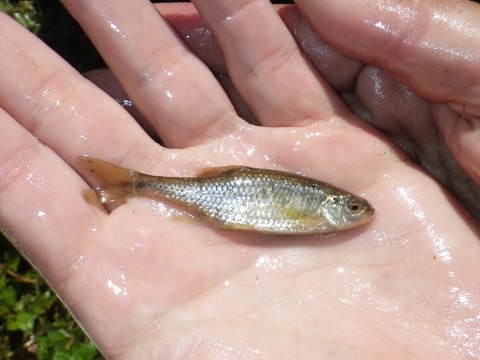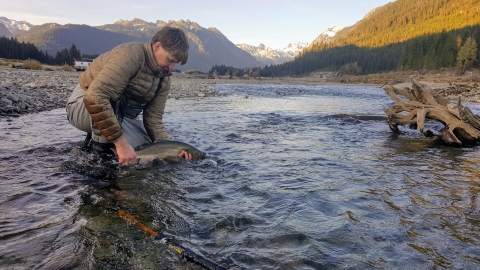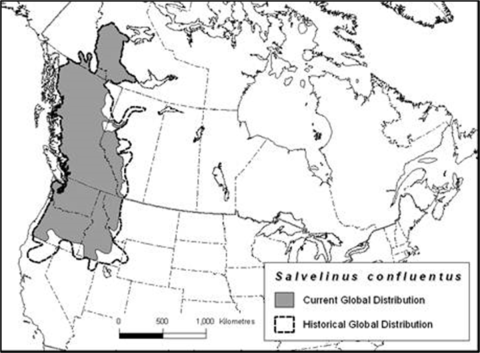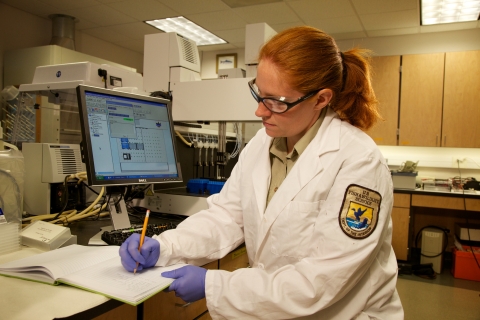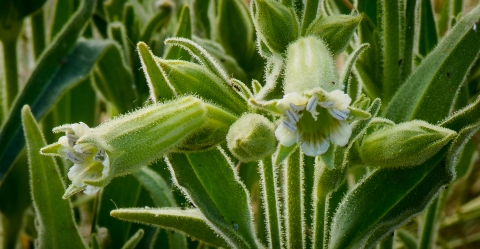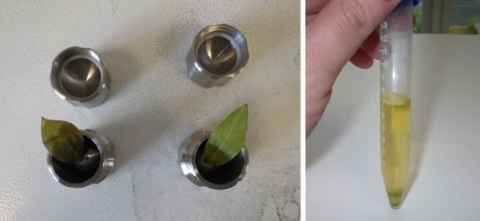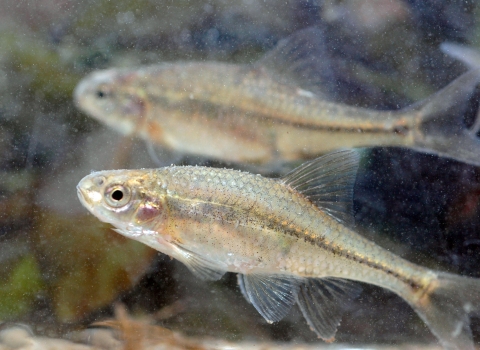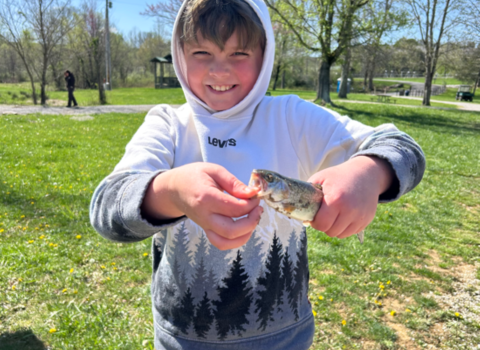This year marks the golden anniversary of the Endangered Species Act, a law that has been a powerful catalyst for conservation of America’s most treasured fish, wildlife, plants and their habitats for five decades. People power the mission of the U.S. Fish and Wildlife Service. Here in the Pacific Region, Tribal, federal and state partners, local supporters, and our dedicated staff, are the driving force behind the successes we share and the strength ensuring we can continue to face the challenges ahead.
Abernathy Fish Technology Center was established to mitigate for the impacts of Bonneville Dam on Pacific salmon. Today, the work at Abernathy falls under three distinct categories: conservation genetics, nutrition and physiology, and quantitative ecology and technology.
These programs provide technical expertise to assist in conservation, mitigation, Tribal trust responsibilities, restoration, and recovery efforts for fishery resources. All of Abernathy’s research involves collaborations with various partners both within and outside of the Service.
Below, we highlight three examples of how Abernathy Fish Technology Center’s work in conservation genetics has informed important decisions for threatened and endangered species listed under the ESA.
ESA Success: Delisting the Oregon Chub
Genetic data supports the first ever delisting of a fish due to recovery
February 19, 2015, was a big day for a little fish native to the Willamette River system in Oregon. On that day, the Oregon chub became the first fish ever to be removed from the federal list of endangered and threatened animals because the recovery goals for the species had been met.
Leading up to this historic event, Abernathy Fish Technology Center geneticists conducted three studies on Oregon chub to evaluate the case for delisting:
- An initial study focusing on development of genetic markers and a baseline for monitoring Oregon chub.
- A second study characterizing genetic variation and effective population size of Oregon chub populations and patterns of divergence among populations.
- A third study using genetic information to examine the movements of Oregon chub from one population to another.
The information generated from these studies supported the determination that Oregon chub had met recovery goals necessary for delisting.
Former Abernathy geneticist Patrick DeHaan was recognized by the Service and the broader scientific community for this work, receiving both the Service’s Recovery Champion Award and the Stevan Phelps Memorial Award for best genetics paper in an American Fisheries Society publication.
Celebrating Recovery and Partnerships
Representative Peter DeFazio of Oregon, state and federal natural resource agency representatives, partner groups, and private landowners, gathered at the William L. Finley National Wildlife Refuge in Corvallis, Oregon to mark the occasion and announce the delisting of the Oregon chub. Every speaker emphasized the strong partnerships between government agencies, non-governmental groups, and private citizens that made Oregon chub recovery possible. At the end of the event, the attendees had the opportunity to see live Oregon chub from ponds on the refuge and enjoyed chub-themed refreshments.
Genetic studies at Abernathy Fish Technology Center have also contributed to numerous ESA status assessments and delisting of fish species beyond the Pacific Region, including the Modoc sucker and Foskett speckled dace.
- Award-winning peer-reviewed article: Influence of Introduction History on Genetic Variation in Introduced Populations: A Case Study of Oregon Chub
- Recovery Champions: 2014 Recovery Champions | U.S. Fish & Wildlife Service
- Related story: Celebrating ESA’s 50th — First Fish Ever Recovered | U.S. Fish & Wildlife Service
ESA Partnerships: Rapid Response Genetic Analysis for Bull Trout
Partners work together to rapidly return bull trout to their natal waters
For two decades, Abernathy Fish Technology Center has been conducting bull trout genetic studies in collaboration with our partners to assist in recovery efforts and to serve as the Service’s genetic repository for bull trout.
Bull trout are listed as threatened under the ESA due to widespread population declines. A common challenge for bull trout is that natal streams where they spawn are separated by dams from the rivers and lakes where they spend their adult lives. Juvenile fish can swim downstream through dams to reach feeding habitat; however, they are blocked by dams when they try to return upstream to spawn. This leaves bull trout from various streams trapped below dams and unable to return to their streams of origin.
Bull trout populations evolve over many generations to become adapted to return to specific natal streams; so, in systems containing multiple dams, it is not feasible to arbitrarily choose where to return the bull trout.
This is where genetic data come in — biologists from the Service, state, and local agencies in the field send genetic samples from the bull trout below the dams to Abernathy Fish Technology Center and hold the fish while they await results.
Genetic samples are express shipped to Abernathy Fish Technology Center and analyzed immediately upon arrival, with results typically available within 4 to 6 hours. Results of this analysis reveal the stream of origin of each fish; this information is then emailed back to the field biologists who use it to determine above which dam to release each fish.
On the Yakima River in Washington, Abernathy geneticists are implementing this process, analyzing samples from bull trout isolated from their spawning grounds by dams and using the results to help return these fish back to their natal waters.
The Yakima River project was initiated in 2017 as a collaboration between the Service and the state of Washington. Our Mid-Columbia Fish and Wildlife Conservation Office developed the “trap and haul” project and secured funding for both the field and lab work, which was largely funded by the Bureau of Reclamation. Mid-Columbia office staff captured and transported the fish, the Washington Department of Fish and Wildlife had a genetic reference baseline for bull trout in the Yakima River, and geneticists at Abernathy Fish Technology Center had the ability to process samples rapidly enough to facilitate fish passage fish passage
Fish passage is the ability of fish or other aquatic species to move freely throughout their life to find food, reproduce, and complete their natural migration cycles. Millions of barriers to fish passage across the country are fragmenting habitat and leading to species declines. The U.S. Fish and Wildlife Service's National Fish Passage Program is working to reconnect watersheds to benefit both wildlife and people.
Learn more about fish passage . In 2019, this project was expanded to include additional dam locations and continues today.
The result: persistence of healthy bull trout populations in one of the most beautiful parts of our country.
Abernathy Fish Technology Center also serves as the Service’s genetic repository for bull trout. This resource, combined with our ability to work across state borders, enables us to conduct range-wide species assessments and develop genetic tools that facilitate data sharing by our many partners working in each of the states that are home to this iconic species. We recently collaborated with the states of Washington, Idaho, and Montana to develop a set of genetic tools based on next-generation DNA sequencing technology that is now being used to improve monitoring of bull trout populations in each of these states.
Peer-reviewed articles:
- Genetic Structure, Evolutionary History, and Conservation Units of Bull Trout in the Coterminous United States
- Developing a Standardized Single Nucleotide Polymorphism Panel for Rangewide Genetic Monitoring of Bull Trout
ESA at Work: Conserving the Spalding’s Catchfly
How geneticists at Abernathy Fish Technology Center joined forces with botanists for the conservation of a threatened plant
Recovery of threatened and endangered species requires knowledge of how genetic diversity is distributed across a species’ range. Such knowledge can be difficult to gain using traditional means but can be informed by examining the species’ DNA.
Spalding’s catchfly is a threatened perennial plant found in grasslands and sagebrush sagebrush
The western United States’ sagebrush country encompasses over 175 million acres of public and private lands. The sagebrush landscape provides many benefits to our rural economies and communities, and it serves as crucial habitat for a diversity of wildlife, including the iconic greater sage-grouse and over 350 other species.
Learn more about sagebrush communities in the Pacific Northwest. The species is under pressure from several factors, including loss or degradation of habitat due to agriculture and competition from invasive, non-native plant species.
The original recovery plan for Spalding’s catchfly identified five geographic conservation units, intended to capture genetic diversity within the species. To evaluate whether this was accurate, our Idaho Ecological Services Office enlisted Peter Lesica, a botanist from University of Montana, and geneticists from Abernathy Fish Technology Center to read the DNA in leaf samples collected from across the species’ range.
Using neutral genetic markers, we identified four population clusters that did not reflect the original conservation units — some of the units being managed independently were essentially identical and could be merged, while one extremely divergent population was being inadvertently lumped in with a larger group. This new information was included in the 5-year status review for Spalding’s catchfly.
Five-year status reviews evaluate available information related to the species status and assess progress toward recovery. The genetic information recently gathered for Spalding’s catchfly provides a new perspective on the distribution of the species that will foster efficient recovery efforts, including conservation of the species’ genetic diversity.
Results of the genetic analysis were published in an article in the Journal Conservation Genetics and presented by Abernathy geneticist Brice Adams at the 2016 Pacific Region Science of the Service symposium: Can physiographic regions substitute for genetically-determined conservation units? A case study with the threatened plant, Silene spaldingii.
Learn more about Abernathy Fish Technology Center: Abernathy Fish Technology Center | U.S. Fish & Wildlife Service (fws.gov)



